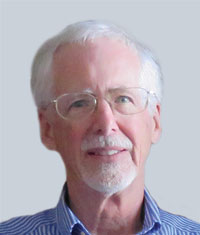AAPG Petroleum Structure and Geomechanics Division (PSGD) Best Paper Awards 2016
The AAPG Petroleum Structure and Geomechanics Division (PSGD) has announced the 2016 Best Paper Awards at the Annual Convention and Exhibition in Calgary, Alberta, Canada. Congratulations to Richard H Groshong, Jr., awarded "Best Seminal Publication" for "3-D Structural Geology: A Practical Guide to Quantitative Surface and Subsurface Map Interpretation 2nd Edition".
We thank everyone for nominating the candidates. We also thank Bob Krantz, Bob Hatcher, and Gary Couples for their diligent work on the PSGD Best Paper Committee.
Best Seminal Publication
Citationist: Van Mount
Recipient: Richard H. Groshong, Jr.
3-D Structural Geology: A Practical Guide to Quantitative Surface and Subsurface Map Interpretation, Second Edition, Springer-Verlag, Berlin, 400 p.
Citation for AAPG Petroleum Structure and Geomechanics Division 2016 Best Paper Awards (category (i) Best Seminal Publication award)
In this book, Rick provides practical techniques for interpreting and mapping geological structures in 2-D and 3-D environments. The book is designed for petroleum industry geotechnical professionals and students, using data typically encountered and interpreted in exploration and development settings.
Fundamental techniques and methods introduced or reviewed in the book are useful to any AAPG member that generates maps or cross sections, or evaluates them as part of their job description. Any young geoscientist with an interest in an industry career would benefit from the introduction to commonly applied industry methods – and a description of their proper application - provided by Rick in this textbook. That being said, the book is applicable to both experienced geoscientists and those new to the industry.
Models and techniques are reinforced with exercises that allow geologists, geophysicists, and engineers to evaluate and/or produce more accurate geological maps and cross sections – skills that can always be enhanced and upgraded in our industry.
Congratulations Rick.
Van Mount
Anadarko Petroleum
Response from Richard H. Groshong, Jr.

Richard H. Groshong, Jr. - "Best Seminal Publication" Award Winner
I am extremely grateful to Van Mount and his colleagues at Anadarko Petroleum for nominating my book for the award, and to the committee of Bob Krantz, Bob Hatcher, and Gary Couples for selecting it.
Thanks for the opportunity to share a few bits about the making of the book. The book grew out of a campaign to interpret the structure of some Alabama oil and gas fields using well logs and the occasional 2-D seismic line. This was a joint effort involving students at The University and Jack Pashin at the Alabama Geological Survey. The book is intended to acquaint a new interpreter with all the available techniques for making structural interpretations from geological data, and to do so quantitatively, reflecting the workstation environment. As I began accumulating material, I realized that I too was a new interpreter. The first edition, which in hindsight turned out to be the beta version, was definitely a process of learning while doing. I might add that the book began as the introduction to a book about balancing, restoring, and kinematic modeling, but the introduction took over.
The second edition benefitted from my experiences teaching subsurface mapping at Alabama and for PetroSkills. I have always learned a lot while teaching. Many industry interpreters primarily use 3-D seismic data, but even 3-D seismic can be sparse and potentially misleading when you are looking at the details. One of my favorite compliments after a class was from someone on a major-company development team who told me later that the class helped him resolve a significant interpretation issue. When I asked him how, he replied that while they always plotted the wells in their 3-D seismic volumes, he had no idea that you could use that information to find faults. One of the most enjoyable aspects of writing the second edition was working with my son and namesake. He was between college and a job, and joined as chief 3-D model builder. Happily, Springer was good enough to make a color version of the text available as a pdf. I would like to finish by thanking three very important people, Wolfgang Engel, my original editor at Springer, Phil LaMoreaux, the man who introduced us, and my wife Kathy, who has managed to live with me through it all.
The AAPG Petroleum Structure and Geomechanics Division (PSGD) announced the 2016 Best Paper Awards at the Annual Convention and Exhibition in Calgary, Alberta, Canada.